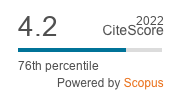Association between soil fauna activity and piping in contrasted environments
DOI:
https://doi.org/10.18172/cig.1247Keywords:
semiarid, alpine Meadows, macrofauna, soil micromorphologyAbstract
Pedological evidences and geomorphic reasons are presented to help determining if soil fauna acts as triggering agent of piping in contrasted environments. The evidences are based on soil properties, essentially soil morphology-micromorphology, but also on soil physics, chemistry and mineralogy. In the edges near the earthen banks of old, abandoned, agricultural terraces in SE Spain, clear sequences of fauna activity (both mesofauna, e.g. tarantules, and macrofauna, e.g. rabbits and foxes) can be seen in relation with piping processes under flooding conditions (once every 4 years in average). Pipe diameters start with a few centimetres (with an estimated sediment production below 1 t ha-1 y-1) and end up with over 0.5 m pipes which usually collapse and become gully heads, causing the partial destruction of large terraces of about 1 ha (with an estimated sediment production over 100 t ha-1 y-1). However, in the Central Pyrenees, in hillslopes up to 30° covered by alpine meadow (e.g. Festuca eskia), a dense network of pipes of a few centimetres of diameter in the boundary between A and B horizons, has its origin in a well developed soil aggregation mainly due to freeze-thaw processes. Once created, this important macroporosity is used by melting waters and by voles (genus Pitymys) to form pipes. Daily subsurface flow measured in one of such pipes is over 9000 L/day and the estimated sediment production at catchment scale is 0.015 t ha-1 y-1. It is discussed that in the first case soil fauna has a triggering role for piping. However, in the second case piping is only enhanced by fauna activity from an already existent network of soil macropores. In a third case, within the Tabernas desert also in semiarid SE Spain, soil fauna doesn’t seem to play any relevant role in piping production.Downloads
References
Bendahmane, F., Marot, D., Alexis, A., (2008). Experimental Parametric Study of Suffusion and Backward Erosion. J. Geotechnical and Geoenvironmental Engineering, 134: 57-67.
Bonelli, S., Brivois, O., (2008). The scaling law in the hole erosion test with a constant pressure drop. International Journal for Numerical and Analytical Methods in Geomechanics, 32: 1573-1595.
Borghi, C.E., (1992). Los micromamíferos subterráneos del Pirineo Aragonés: impacto sobre la vegetación y papel bioerosivo. Tesis doctoral inédita, Universidad Autónoma de Madrid.
Borghi, C.E., Giannoni, S.M., Martínez-Rica, J.P., (1990). Soil removed by voles of the genus Pitymys in the Spanish Pyrenees. Pirineos, 136: 3-18.
Bryan, R.B., Jones, J.A.A. (1997). The significance of soil piping processes: inventory and prospect. Geomorphology, 20: 209-218.
Cantón, Y., Solé-Benet, A., Queralt, I., Pini, R., (2001a). Weathering of a gypsum calcareous mudstone under semi-arid environment at Tabernas, SE Spain: laboratory and field-based experimental approaches. Catena, 44: 111-132.
Cantón, Y., Domingo, F., Solé-Benet, A., Puigdefábregas, J., (2001b). Hydrological and erosion response of a badlands system in semiarid SE Spain. J. Hydrol., 252 (1-4): 65-84.
Cantón, Y., Solé-Benet, A., Lázaro, R., (2003). Soil-geomorphology relations in gypsiferous materials of the Tabernas desert (Almería, SE Spain). Geoderma, 115: 193-222.
Domingo, F., Villagarcía, L., Boer, M. M., Alados-Arboledas, L., Puigdefábregas, J., (2001). Evaluating the long-term water balance of arid zone stream bed vegetation using evapotranspiration modelling and hillslope runoff measurements. Journal of Hydrology, 243: 17-30.
Fell, R., Fry, J.J., (2007). Internal erosion of dams and their foundations. Taylor & Francis, London.
García-Ruiz, J.M., Lasanta, T., Ortigosa, L., Arnáez, J., (1986). Pipes in cultivated soils of La Rioja: origin and evolution, Z. Geomorphol., Suppl. 58: 93-100.
García-Ruiz, J.M., Lasanta, T., Alberto, F., (1997). Soil erosion by piping in irrigated fields. Geomorphology, 20: 269-278.
Gutiérrez, M., Sancho, C., Benito, G., Sirvent, J., Desir, G., (1997). Quantitative study of piping processes in badland areas of the Ebro basin (NE Spain). Geomorphology, 20: 237-253.
Hanson, G.J., Tejral, R.D., Hunt, S.L., Temple, D.M., (2010). Internal erosion and impact of erosion resistance. Proceedings of the 30th U.S. Society on Dams Annual Meeting and Conference, Sacramento, California, pp 773-784.
Ibáñez, J.J., ( 2010). Abismos bajo el suelo: erosión por sufusión y desastres naturales. En Un universo invisible bajo nuestros pies. MI+D un lugar para la ciencia y la tecnología, 5-09-2010, http://www.madrimasd.org/blogs/universo/
Imeson, A. C., Kwaad, J. P. M., (1976). Some effects of burrowing animals on slope processes in the Luxembourg Ardennes. Part 2: The erosion of animal mounds by splash under the forest. Geografiska Annaler. 58A: 115-125.
Jones, J.A.A. (1981). The Nature of Soil Piping, a Review of Research. Geobooks, Norwich, 301 pp.
López-Bermúdez, F., Torcal, L., (1986). Procesos de erosión en túnel (piping) en cuencas sedimentarias de Murcia (España). Estudio preliminar mediante difracción de rayos X y microscopio electrónico de barrido. Papeles de Geografía Física, 11: 7-20.
Marot, D., Bendahmane, F., Alexis, A., (2006). Experiments on backward erosion and suffusion. In EWG Internal Erosion, Stockholm, Sept 11-12, 2006.
Mc Cook, D. K., (2004). A comprehensive discussion of piping and internal erosion failure mechanisms. Proc. of the 2004 Annual Association of State Dam Safety Officials, Phoenix, Arizona, USA, pp 1-6.
Nicolau, J.M., Solé-Benet, A., Puigdefábregas, J. y Gutiérrez, L., (1996). Effects of soil and vegetation on runoff along a catena in semi-arid Spain. Geomorphology, 14:297-309.
Onda, Y, Itakura, N., (1997). An experimental study on the burrowing activity of river crabs on subsurface water movement and piping erosion. Geomorphology, 20: 279-288.
Petterson, D., (2001). The effects of the wild rabbit (Oryctolagus cuniculus) on soils and vegetation in semi-arid, south-eastern Spain. Tesis doctoral inédita, Universidad de Leeds, Reino Unido.
Puigdefábregas, J., Aguilera, C., Brenner, A., Clarck, S., Cueto, M., Delgado, L., Domingo, F., Gutiérrez, L., Incoll, L., Lázaro, R., Nicolau, J.M., Sánchez, G., Solé, A., Vidal, S., (1996). The Rambla Honda field site. Interactions of soil and vegetation along a catena in semi-arid SE Spain. En Mediterranean Desertification and Land Use, (Thornes, J., Brandt, J., Eds.) pp 137-168, John Wiley & sons, Reino Unido.
Solé Benet, A., Cantón, Y., Lázaro, R., Puigdefábregas, J., (2009). Meteorización y erosión en el sub-desierto de Tabernas, Almería. Cuadernos de Investigación Geográfica, 35: 151-163.
Solé Benet, A., Lázaro, R., Domingo, F., Cantón, Y., Puigdefábregas, J., (2010). Why most agricultural terraces in steep slopes in semiarid SE Spain remain well preserved since their abandonment 50 years ago? Pirineos, 165: 215-235.
Terzaghi, K., Peck, R.B., (1967). Soil Mechanics in Engineering Practice. 2nd Ed., John Wiley & sons, New York.
Wan, C.F., Fell, R., (2002). Investigation of internal erosion and piping of soils in embankment dams by the slot erosion test and the hole erosion test-interpretative report. UNICIV REPORT R-412, The University of New South Wales, Sydney, Australia, 358 p.
Downloads
Published
How to Cite
Issue
Section
License
The authors retain copyright of articles and authorize Cuadernos de Investigación Geográfica / Geographical Research Letters the first publication. They are free to share and redistribute the article without obtaining permission from the publisher as long as they give appropriate credit to the editor and the journal.
Self-archiving is allowed too. In fact, it is recommendable to deposit a PDF version of the paper in academic and/or institutional repositories.
It is recommended to include the DOI number.
This journal is licensed under a Creative Commons Attribution 4.0 International License











